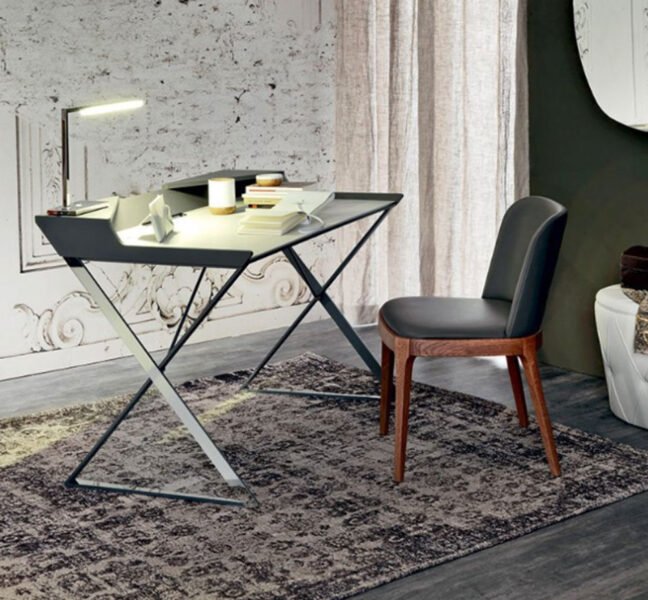Skip to the good bit
ToggleItalian dining chairs are known for their exceptional craftsmanship, elegant silhouettes, and timeless appeal. Rooted in a deep design heritage, these chairs often reflect a balance of aesthetics and function. Clean lines, graceful curves, and attention to proportion make them suitable for both traditional and contemporary interiors.
Materials play a significant role in defining the character and durability of Italian dining chairs. Solid wood, such as beech or walnut, is often used for its strength and natural beauty. Upholstered versions may feature premium fabrics or fine leather, offering enhanced comfort and texture. Metal and molded plastic are also used in modern designs, adding versatility.
When choosing Italian dining chairs, buyers should consider room size, table height, and frequency of use. Prioritizing ergonomics and cohesive design can lead to a more satisfying investment. With a variety of styles available, these chairs provide both visual appeal and long-lasting performance in any dining environment.
Overview of Italian dining chair craftsmanship and regional distinctions
Italian dining chairs represent a legacy of exceptional craftsmanship rooted in centuries of furniture-making tradition. Artisans across Italy have passed down techniques that emphasize precision, artistic detail, and lasting quality. Each chair is often a product of meticulous handwork, combining beauty with function to enhance both comfort and visual appeal.
Regional distinctions contribute to the diversity of Italian dining chairs. In the north, areas such as Lombardy and Veneto are known for refined woodworking and modern design influences, often using walnut, ash, or oak. Tuscany highlights rustic elegance with hand-carved details and natural finishes that reflect a warm, traditional character.
Southern regions may showcase more decorative elements, including inlays and curved silhouettes inspired by classical motifs. Whether minimalist or ornate, every chair speaks to Italy’s dedication to design excellence.
Buyers can choose from a variety of styles, each reflecting the cultural richness and regional techniques that make Italian dining chairs a distinctive furnishing choice.
Common materials used in Italian dining chairs: Wood, metal, and upholstery options
Italian dining chairs are crafted using a variety of materials chosen for both aesthetic appeal and functional strength. Wood remains the most traditional and widely used material. Options such as beech, walnut, and oak offer durability, natural texture, and design versatility. These woods are often finished with stains or varnishes to enhance grain and increase resistance to wear.
Metal is frequently used for more contemporary styles. Stainless steel, chrome, and powder-coated frames add a sleek appearance while providing structural support. These choices are particularly popular in minimalist or industrial-inspired interiors, where clean lines and visual lightness are desired.
Upholstery adds comfort and elegance to italian dining chairs. Leather and fabric covers range from smooth, luxurious textures to more practical, easy-clean options. Padded seats and backs enhance ergonomic support, making the chairs suitable for long meals and extended use.
Each material contributes uniquely to the overall character, ensuring functionality and refined design.
Ergonomics and comfort: Evaluating seat height, support, and usage
Ergonomics and comfort are essential factors when selecting italian dining chairs, especially for everyday use. Proper seat height supports posture and allows feet to rest flat on the floor, which is important for circulation and balance. Most dining chairs are designed with a standard height that suits common table dimensions, promoting ease of movement and access.
Support also plays a crucial role in long-term comfort. Chairs with contoured backrests encourage natural alignment of the spine, helping to reduce fatigue during extended meals. Some models offer padded or slightly curved seats to distribute pressure evenly and improve sitting posture.
The intended usage of italian dining chairs should guide the selection process. If chairs will be used frequently, look for durable materials and ergonomic shaping that ensures sustained comfort. For occasional use, style may take priority, but basic ergonomic principles should still be considered. Combining visual appeal with thoughtful design leads to better everyday experiences.
Popular design styles: From traditional to modern Italian aesthetics
Italian dining chairs reflect a rich variety of design styles, blending heritage with innovation. Traditional styles often feature detailed carvings, ornate lines, and natural wood finishes. These chairs may incorporate classical elements such as curved legs, scroll backs, and warm tones that evoke the charm of old-world Italian interiors.
Transitioning into more contemporary aesthetics, modern Italian dining chairs focus on clean profiles, minimal ornamentation, and functional shapes. Materials like polished metal, molded plastic, and smooth leather are frequently used to create sleek forms that prioritize comfort and visual clarity. The color palette tends to include neutral tones, but bold accents also appear in modern collections.
There are also transitional designs that combine classic craftsmanship with updated materials or finishes. These pieces appeal to those who value tradition but seek a fresh look. The evolving range of Italian dining chairs continues to represent Italy’s dedication to artistry, elegance, and thoughtful living.
Durability and construction quality: What to assess before purchasing
Durability and construction quality are essential factors to evaluate when considering new dining furniture. Well-crafted chairs should offer lasting support and retain their form despite daily use. Begin by examining the materials used—solid hardwood frames like beech or oak generally offer superior strength compared to particleboard or lower-grade timber.
Joinery also provides insight into build quality. Look for methods such as mortise-and-tenon or dowel joints, which promote stability and reduce the risk of wobbling over time. Metal fasteners and reinforcement plates are often used to enhance structural integrity further.
Seat comfort and padding durability are also important. High-density foam or layered cushioning maintains shape longer and provides consistent ergonomic support. Upholstery should be tightly fitted, with double stitching that resists wear and fraying.
Whether you are furnishing a family dining area or a formal space, carefully assessing these elements will help ensure that your investment in dining chairs remains functional and visually appealing.
Customization possibilities: Sizing, finishes, and upholstery selections
Customization plays a vital role in creating dining furniture that meets both aesthetic preferences and practical needs. Italian dining chairs are available in various sizes to suit different table heights and room dimensions. Choosing the correct chair height ensures comfort and proper alignment during meals, especially when paired with a matching dining table.
Finish options add another layer of personalization. From natural wood tones that showcase grain patterns to painted or lacquered surfaces in a range of colors, these choices help harmonize the chair with surrounding décor. Matte or glossy finishes can also change the overall impression, from understated elegance to contemporary polish.
Upholstery selections offer further variety. Customers may choose from premium fabrics, soft leathers, or synthetic alternatives—each offering distinct textures and levels of durability. Color and stitching options allow for more detailed coordination with existing interior elements. These customization possibilities make Italian dining chairs adaptable and appealing for diverse household settings.
Integration with dining tables: Coordinating design and proportion
Coordinating dining chairs with tables requires attention to both design harmony and physical proportion. A balanced setup ensures comfort and visual unity in the dining area. The seat height of the chairs should allow adequate legroom between the seat and tabletop, typically leaving around 25 to 30 centimeters of space for comfortable use.
Design coordination involves selecting chairs that complement the style and materials of the table. For instance, modern tables with clean lines pair well with minimalist chairs, while rustic wood tables may benefit from more traditional or upholstered seating. Consistent colors or complementary finishes help maintain a cohesive appearance.
Proportion also plays a critical role. Chairs should not appear too large or too small relative to the table, as this can disrupt the aesthetic balance. Matching the width and volume of the chairs with the table’s scale contributes to a pleasing, functional arrangement that enhances both comfort and style.
Maintenance and care guidelines for longevity
Preserving the quality and appearance of dining chairs requires regular care and mindful usage. Routine cleaning is essential to prevent dust accumulation and surface damage. For wooden or metal frames, use a soft, damp cloth followed by a dry wipe to avoid moisture absorption. Avoid abrasive sponges or harsh chemicals that may harm the finish.
For upholstered italian dining chairs, vacuum gently to remove debris, especially in seams and corners. Fabric covers benefit from occasional spot-cleaning using mild, fabric-safe cleansers. If the upholstery is removable, follow the manufacturer’s laundering instructions for best results. Leather seats should be dusted regularly and treated with appropriate conditioners to prevent cracking or discoloration.
Key factors to consider when choosing Italian dining chairs for your home
When selecting Italian dining chairs for your home, it is important to balance functionality, style, and comfort. Begin by assessing the available space and dimensions of your dining area. This ensures the chairs fit comfortably around the table without restricting movement or access.
Next, evaluate design preferences. Italian dining chairs are offered in various styles, from ornate classical designs to streamlined modern silhouettes. Choosing a style that harmonizes with your table and existing décor will help create a cohesive setting. Consider finishes, colors, and materials that reflect your interior theme.







